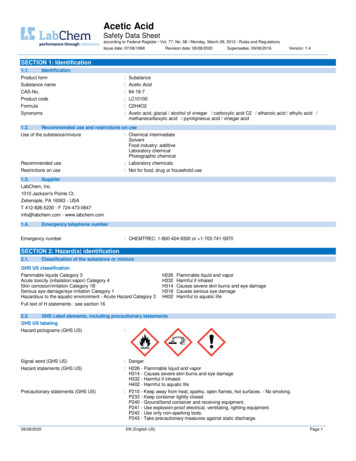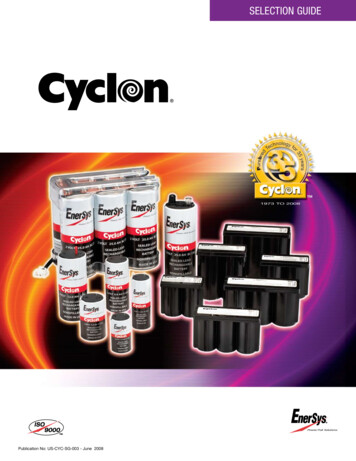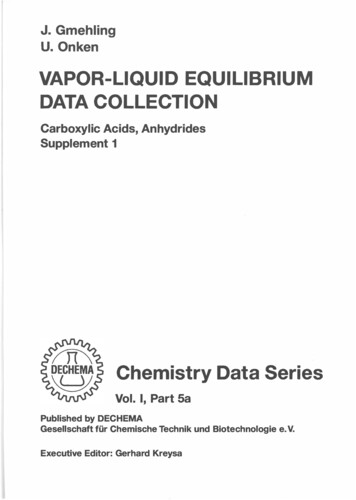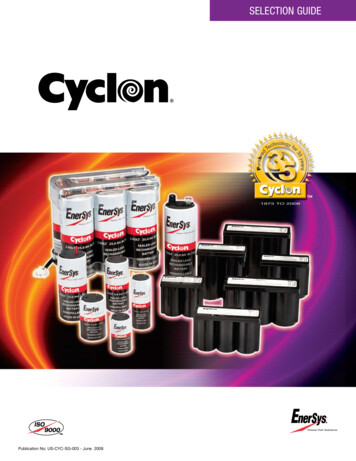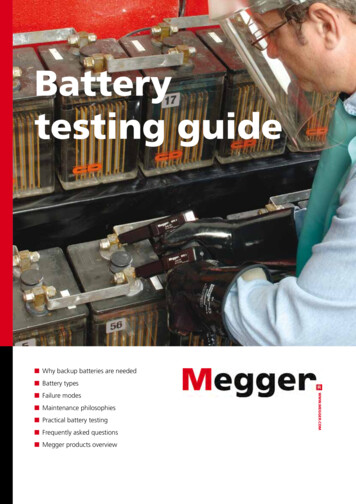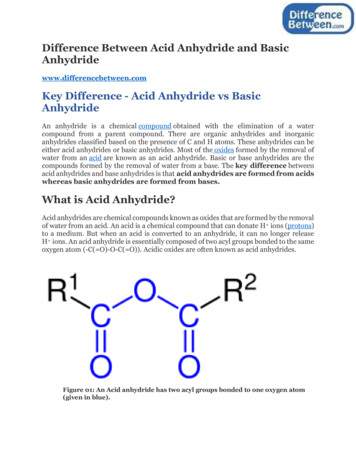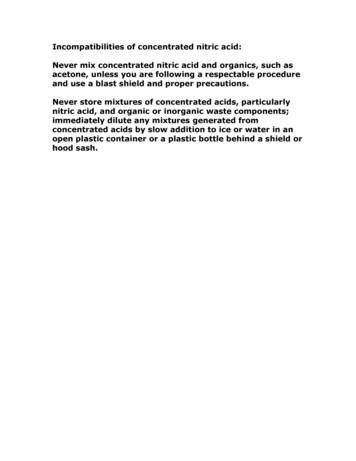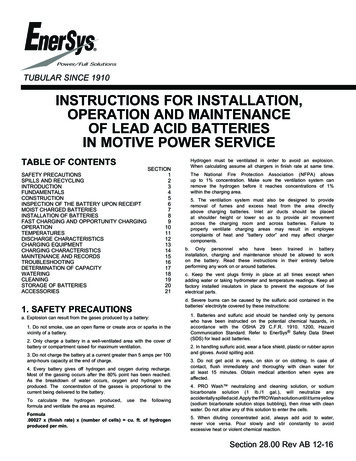
Transcription
TUBULAR SINCE 1910INSTRUCTIONS FOR INSTALLATION,OPERATION AND MAINTENANCEOF LEAD ACID BATTERIESIN MOTIVE POWER SERVICETABLE OF CONTENTSSAFETY PRECAUTIONSSPILLS AND CTION OF THE BATTERY UPON RECEIPTMOIST CHARGED BATTERIESINSTALLATION OF BATTERIESFAST CHARGING AND OPPORTUNITY CHARGINGOPERATIONTEMPERATURESDISCHARGE CHARACTERISTICSCHARGING EQUIPMENTCHARGING CHARACTERISTICSMAINTENANCE AND RECORDSTROUBLESHOOTINGDETERMINATION OF CAPACITYWATERINGCLEANINGSTORAGE OF BATTERIESACCESSORIESHydrogen must be ventilated in order to avoid an explosion.When calculating assume all chargers in finish rate at same time.SECTION123456789101112131415161718192021The National Fire Protection Association (NFPA) allowsup to 1% concentration. Make sure the ventilation system canremove the hydrogen before it reaches concentrations of 1%within the charging area.5. The ventilation system must also be designed to provideremoval of fumes and excess heat from the area directlyabove charging batteries. Inlet air ducts should be placedat shoulder height or lower so as to provide air movementacross the charging room and across batteries. Failure toproperly ventilate charging areas may result in employeecomplaints of heat and “battery odor” and may affect chargercomponents.b. Only personnel who have been trained in batteryinstallation, charging and maintenance should be allowed to workon the battery. Read these instructions in their entirety beforeperforming any work on or around batteries.c. Keep the vent plugs firmly in place at all times except whenadding water or taking hydrometer and temperature readings. Keep allfactory installed insulators in place to prevent the exposure of liveelectrical parts.d. Severe burns can be caused by the sulfuric acid contained in thebatteries’ electrolyte covered by these instructions:1. SAFETY PRECAUTIONS1. Batteries and sulfuric acid should be handled only by personswho have been instructed on the potential chemical hazards, inaccordance with the OSHA 29 C.F.R. 1910. 1200, HazardCommunication Standard. Refer to EnerSys Safety Data Sheet(SDS) for lead acid batteries.a. Explosion can result from the gases produced by a battery:1. Do not smoke, use an open flame or create arcs or sparks in thevicinity of a battery.2. Only charge a battery in a well-ventilated area with the cover ofbattery or compartment raised for maximum ventilation.2. In handling sulfuric acid, wear a face shield, plastic or rubber apronand gloves. Avoid spilling acid.3. Do not charge the battery at a current greater than 5 amps per 100amp-hours capacity at the end of charge.3. Do not get acid in eyes, on skin or on clothing. In case ofcontact, flush immediately and thoroughly with clean water forat least 15 minutes. Obtain medical attention when eyes areaffected.4. Every battery gives off hydrogen and oxygen during recharge.Most of the gassing occurs after the 80% point has been reached.As the breakdown of water occurs, oxygen and hydrogen areproduced. The concentration of the gasses is proportional to thecurrent being delivered to the battery.To calculate the hydrogen produced,formula and ventilate the area as required.usethe4. PRO Wash neutralizing and cleaning solution, or sodiumbicarbonate solution (1 lb./1 gal.), will neutralize anyaccidentally spilled acid. Apply the PRO Wash solution until it turns yellow(sodium bicarbonate solution stops bubbling), then rinse with cleanwater. Do not allow any of this solution to enter the cells.followingFormula.00027 x (finish rate) x (number of cells) cu. ft. of hydrogenproduced per min.5. When diluting concentrated acid, always add acid to water,never vice versa. Pour slowly and stir constantly to avoidexcessive heat or violent chemical reaction.1Section 28.00 Rev AB 12-16
e. The battery is electrically alive at all times:c. Recycling:1. Keep the top of the battery clean and dry to prevent ground shortsand corrosion.1. Spent lead acid batteries which are destined for recycling are notregulated under federal hazardous waste regulations or by most stateregulations. Contact your state environment agency for additionalinformation.2. Do not lay metallic objects on the battery; insulate all tools usedin working on the battery to prevent short circuits. Remove alljewelry before working on the battery.2. Under federal land ban restrictions and individual state batteryrecycling laws, spent lead acid batteries can be disposed of onlyby recycling/reclamation at permitted secondary lead smelters orother authorized recycling facilities. Spent batteries should be sentonly to facilities which have obtained EPA or state hazardouswaste permits for the storage of spent batteries prior to recycling. Call1-800-EnerSys for EnerSys Battery Recycling.3. Be especially careful when working on battery terminalconnections. High voltage capable of electric shocks or burnsmay be present. Make sure all terminal connections areproperly insulated for safety.f. When lifting the battery, observe the following precautions:1. Follow the instructions on handling loads covered in OSHA 29C.F.R. 1910. 1798(n).3. Acid which is removed from spent batteries may be regulatedhazardous waste. Facilities which generate spent acid may be subjectto state or federal regulations for large or small quantity generatorsapplicable to labeling, manifesting, transporting and reporting.2. Use a lifting device with two hooks which are electricallyinsulated from each other to prevent short circuits. Use a lifting beamthat is completely insulated if possible, like an EnerSys PRO Series Adjustable Lifting Beam.3. INTRODUCTION3. When completely insulated lifting beams are not available,temporarily cover the exposed metal components of the cells with aninsulating material (plywood, thick rubber, etc.) to reduce the risk of ashort circuit from the chain or hooks.Whether it be in a warehouse, a manufacturing plant, in a mine or inairline ground support equipment, battery-propelled vehicles havean advantage over other means of transporting equipment. The vitalpower source of these vehicles is a storage battery. The purpose of thismanual is to provide a better understanding of the characteristics,operation and care of this battery so that all of its advantages andeconomies may be realized.2. SPILLS AND RECYCLINGa. Spills of sulfuric acid should be handled with consideration for thefollowing:4. FUNDAMENTALS1. Do not touch spilled materials without appropriate personalprotective equipment (e.g. face shield, acid resistant gloves, etc.).Battery: a device for converting chemical energy into electricalenergy. All batteries are made up of individual compartments called cells,connected in series. Size, internal design and the materials usedcontrol the amount of energy available from each cell. A lead acidbattery is a number of cells filled with a mixture of sulfuric acid and watercalled electrolyte. The electrolyte covers vertical plates made of twotypes of lead. Chemical action between the electrolyte and the leadcreates electrical energy.2. If possible, stop the flow of spilled acid with sand or othernon-combustible absorbent. Neutralize with PRO Wash or otherneutralizing agent.3. Place spill residue into compatible containers. If spilloccurs from a battery, waste should be tested for presence ofhazardous constituents prior to disposal.4. Do not allow the discharge of any electrolyte or acid intosanitary or storm sewers.Volt (V): the standard measure of electrical potential. A DC forklift’srunning speed and lifting speed are determined by a battery’s voltage.AC forklifts typically draw a consistent level of power (Watts) from thebattery, which means higher voltage batteries will require lower currentdraws to do the same work (Watts Volts x Amperes). The advantage ofhigher battery voltages in AC lift trucks is lower ampere draws leading toextended run times. Since each cell in a lead acid battery hasapproximately 2 volts, multiply the number of cells by 2 to determine theterminal (overall) voltage. Forklifts are rated for a specific voltage battery.5. Spills which enter the environment (through sewers,waterways or soil) must be reported, as applicable, to city, state and/or federal environmental agencies as necessary.6. Spills which occur during transportation of batteries should bereported to CHEMTREC (1-800-424-9300) - a 24-hour service foremergency assistance.b. Handling and storage of new and used (spent) batteries:Ampere (A): the standard measure of the amount of electric current.The amount or flow can be large (amperes) or small (milliamperes).Flashlight batteries are measured in milliamperes. Lift truck batterycurrent is measured in amperes. While it is important to match batterysize with the maximum amperage requirements of a forklift truck, themost important factor to keep a truck running for an entire shift is the totalcapacity the battery has available, i.e. Ampere-hours.1. Batteries and battery components should be handled only inaccordance with the safety procedure outlined in Section 1.2. All batteries, as well as other hazardous substances, shouldbe stored under cover and on an impervious surface withadequate containment to prevent dispersion of containments to theenvironment.3. Batteries and acids should be stored away from sewer and stormdrains and from sources of heat.Ampere-hour (Ah): the amount of current the battery can supplymultiplied by the length of time the battery is discharged. The higher abattery’s ampere-hour capacity, the longer a forklift will run. The amphour capacity varies with the length of the discharge. American forkliftbattery manufacturers rate their battery at the 6 hour rate. For example,a hypothetical battery has a rating of 680 ampere-hours (Ah) at the 6 hourrate. By dividing 680 Ah by 6 hours, a discharge rate of 113 amperes isdetermined. This means if a forklift’s motor and attachments draw 113amperes continuously, the battery will be completely drained of usablepower in six hours. To maximize the life of your battery, it should not bedischarged below 80% depth of discharge.4. Leaking or cracked batteries and cells must be contained toprevent further leakage.5. Generally, there are no storage time restrictions for batteriesor for spent lead acid batteries which are destined for recycling.However, state regulations and local fire and health ordinancesshould be consulted for special restrictions on the storage ofhazardous substances, including batteries and acid.6. Sulfuric acid is listed as an extremely hazardoussubstance under the federal Emergency Planning and CommunityRight-to-Know Act (EPCRA). Notification and/or reporting tofederal, state and local agencies may be required if the thresholdplanning quantity (TPQ) of sulfuric acid is exceeded, which is 1,000pounds.2
5. CONSTRUCTIONWatt (W): the standard measure of electrical power. Multiplying voltsby amperes determines watts. Every 1,000 watts is a kilowatt (kW).The total capacity available from a battery can be determined bymultiplying wattage by the length of the discharge. For example, if yourforklift needs 10 kW of continuous power for a 6-hour shift, you need abattery that provides 60-kilowatt hours (60 kWh) of energy.Figure 2 illustrates the construction of a typical motive power cell of thetubular design.FIGURE 2Cycle: Every time a battery is charged and then discharged in useis one cycle. Battery life is usually measured in cycles. In a oneshift per day operation, a battery designed for 1,200 to 1,500 80%discharge cycles should last 5 or 6 years. However, batterymaintenance and charging procedures will either prolong or shortenbattery life depending on how well recommended procedures arefollowed. EnerSys will provide training aids and materials wheneverrequested. Also, when a battery’s average voltage measures less than2.08 volts (open circuit-after a full charge) times the total number of cells,the battery either needs repair or has reached the end of its life. To besure the situation isn’t the result of a maintenance problem, call your lifttruck dealer or EnerSys representative.Specific Gravity: As a battery is used, the sulfuric acid in theelectrolyte changes into another chemical when it combines withthe active material. As a result there is less and lesspower-generating sulfuric acid as the battery is discharged. When thebattery is recharged, the sulfuric acid returns.FIGURE 11.2.3.4.5.6.Positive PostNegative PostPositive PlateNegative PlateNegative GridPositive Spine07.08.09.10.11.12.SeparatorVent CapJarCoverBridgeVent Well6. INSPECTION OF THEBATTERY UPON RECEIPTa. Examine for physical damage or loss of electrolyte.b. Report actual or suspected damage to carrier.c. Give battery an equalizing charge. (See Section 14.)d. Check electrolyte levels IMMEDIATELY after charge and add waterif needed.e. When adding water, the electrolyte height should be as specified inSection 18.7. MOIST CHARGED BATTERIESa. Moist charged batteries are electrically live upon receipt, even beforefilling with electrolyte. Do NOT lay any metallic objects on the battery.The hydrometer detects the chemical change by measuring the ratio of sulfuricacid to water. In addition, temperature also affects a battery’s specific gravity.Temperatures above and below 77 F require correction of the hydrometerreading. EnerSys can provide a thermometer which shows how much tocorrect for the temperature at your location.b. Moist charged batteries or cells should be activated (unsealed,filled with electrolyte and charged) only when ready to be placed inservice. Until ready for use, they must be stored in a cool, dry, lowhumidity location with the pressure relief valves/vent plugs tightly inplace. Moist charged cells must be activated within 24 hours of theloosening/breaking of the seal of the pressure relief valves/vent plugs.Gassing: Gassing occurs when the battery does not accept someor all of the charge current. This normally occurs during the last20% of a charging cycle. The water in the electrolyte inside thebattery breaks down into hydrogen and oxygen. When this happens,electrolyte will bubble and expand causing the battery to overflowif any cell was previously filled with too much water. Inexperiencedmaintenance personnel should never try to replace lost sulfuric acid.Under-watering is even worse than over-watering. The electrolytelevel must be above the cell’s separator protector during charging anduse. Otherwise, part of the plates will be unused. The battery will thenoverheat and gas more violently. The exposed plates will eventually dryout and become permanently damaged. Scheduled maintenance mustbe performed if a battery is to work to its full rated capacity.CAUTION: IF THE EXISTING VENT PLUG HAS A LABEL MARKED“DO NOT REMOVE”, STOP ALL ACTIVITY AND CALL YOUR LOCALENERSYS REPRESENTATIVE.c. To prepare for use carefully remove the sealed PRV (pressurerelief valve) using an approved tool or, if necessary, a wide-grip pliers,taking care not to damage the cell vent well exterior. THROW AWAYTHE PRESSURE RELIEF VALVE/ VENT PLUG. Fill all cells withelectrolyte 0.015 sp. gr. lower than the nominal operating gravity.d. Give the battery an equalizing charge, but keep resetting thecharger to the equalize position until the specific gravities remainconstant for a period of three hours. At no time should batterytemperature be allowed to exceed 110 F (43 C).3SECTION 28.00 REV AB 12-16
Fast charging is intended to extend a battery’s run-time during ashift or day. A typical fast charging system will provide charge ratesfrom 26 to 50 amps per 100 amp-hours of a battery’s nameplatecapacity. Fast charging requires special chargers that can monitor andmanage battery temperatures during charge, limit battery gassingto no more than one hour per 24 period (with the exception ofthe Equalization Charge), assure a battery is recharged to at least90% state of charge on a daily basis and automatically provide anEqualization Charge at least once per week. Also, a fast chargebattery should be designed to accept higher charge current and tomanage heat that may be created by higher charging rates. A fast chargesystem, including the battery and charger, should be designed to utilizeno more than 160% of the battery’s 6-hour capacity rating in a shift day.Under fast charging procedures outlined in this paragraph, special fastcharging warranties apply.e. At the completion of the charge, the specific gravities of all cellscorrected to 77 F (25 C) should be as specified on the batterynameplate or shown in Table 3. If the specific gravity is higher, removesome electrolyte and replace with water; if lower, remove someelectrolyte and replace with higher specific gravity electrolyte. Anyspecific gravity adjustments should be made with the charger onequalize in order to mix the electrolyte properly. Removedelectrolyte must be disposed of in strict accordance with all environmentalregulations.f. Upon completion of the above steps, apply a standard vent cap to allcells.8. INSTALLATION OF BATTERIESa. The battery compartment in the vehicle should be ventilated anddesigned in a manner to keep out water, oil, dirt and other foreignmatter. Drainage holes should be located in the floor of the batterycompartment. Consult with your vehicle dealer if any questions arise.If engaging in opportunity charging or fast charging, the batterymust be returned to nameplate specific gravity at least once perweek (Equalization Charge). However, a daily recharge to nameplatespecific gravity is desirable.b. When lifting the battery, use an EnerSys PRO Series AdjustableLifting Beam which exerts a vertical pull on the lifting tabs only.10. OPERATIONc. The battery should be blocked, not wedged, to allow 1/8” minimumclearance on all sides for easy removal from the battery compartment.Excessive clearance will allow the battery to move inside the batterycompartment which may cause damage.a. Full charge specific gravity of a new battery will be specified onthe nameplate located on the side of the battery tray. Full chargespecific gravity will be affected by temperature, acid level andbattery age. If acid is lost from overfilling, full charge specific gravity andcapacity will be lowered.d. During transit and storage, a battery may have lost some of itscharge. Give it an equalizing charge before putting the battery inservice. (See Section 14.)b. Under normal conditions, only add water. NEVER add acid or othersolutions to the cells.e. If any connections on the battery itself are bolted together, makethem clean and bright, using care not to remove the lead coating fromany lead-plated copper parts. Coat the surfaces to be bolted togetherwith NO-OX grease. Torque all bolted connections to 120 in-lbs unlessotherwise specified. Due to vibration, handling and heating duringoperation bolted connections loosen over time. Re-tighten them at leasttwice yearly using an appropriately set torque wrench.c. Keep the plugs and receptacles in good condition. Whendisconnecting battery from the truck or charger, pull on thereceptacle, not the cable. When disconnecting from a charger,assure that the charger is off first; otherwise, arcing will result.Arcing can cause battery explosion, damage to connector contacts andcharger components.f. No intermediate “taps” or connections should be made other than at themain terminal of the battery. Any lower voltage device should be suppliedthrough a series resistor or from a separate source. Any such deviceconnected to an intermediate point of a battery can void your warranty.11. TEMPERATURESa. Low Temperatures. The capacity of a storage battery is reduced atlow temperatures due to the increased viscosity and resistance of theelectrolyte. An approximation of this reduction in capacity for batteries ofthese types is shown below.TAPPING THE BATTERY SHORTENS ITS LIFEBY UP TO THREE YEARS.g. Storage - see Section 20.TABLE 19. FAST CHARGING ANDOPPORTUNITY CHARGINGIf a single battery is being used in a lift truck for multiple shifts or ispartially recharged during breaks, lunches and other idle periods, it maybe in a fast charge or opportunity charge mode of operation.Opportunity charging can be used to keep the battery’s state ofcharge above 30% depth of discharge during the daily discharge cyclethereby reducing or even eliminating the need to change out spentbatteries in a heavy single shift or multi shift operation. Opportunitychargers need to limit battery gassing to one hour per 24 hourperiod (with the exception of the Equalization Charge). The totalaccumulated discharged ampere-hours should not exceed 120% of thebatteries designed capacity rating per day. Discharge of more than 120%of the batteries designed capacity rating in a 24-hour period will shortenbattery life. Charge rates during opportunity charging should not exceed25 amps per 100 amp-hours of a battery’s nameplate capacity. Underthe opportunity charging procedures outlined in this paragraph, specialopportunity battery warranties apply.Internal Temperatureof Cell ( F)PercentCapacity77100609540872073This, of course, refers to the actual temperature of the cell and notthe ambient temperature. Thus a battery may be operated in quitelow ambient temperatures for short periods without the actual batterytemperature falling to a point where the capacity is seriously curtailed.For example, batteries used in cold storage plants or similar locations willdeliver close to normal capacity if they are moved into warmer areas forcharging and whenever not in actual use.Low temperatures also increase the battery voltage on charge,resulting in lower charge currents and a longer recharge time.Undercharging could occur unless charger adjustments are madeto compensate.There is little danger of freezing of the battery electrolyte in temperateclimates unless the battery is completely discharged. At thetemperatures shown in the following table, the electrolyte will not freezeunless the specific gravity is lower than indicated.4
TABLE 2Battery Specific Gravity(Corrected to 77 F)Freezes @ or BelowDegrees F1.080 201.130 101.16001.180-101.200-201.215-301.225-40c. During discharge there is normally a rise in battery temperature,depending on the ambient temperature, on the rate of discharge andthe type of battery assembly from the standpoint of heat dissipation. Thehigher the ampere discharge rate, the greater the temperature rise effect.During discharge, a battery’s temperature will normally rise. The speedand magnitude of this temperature rise is dependent on the followingconditions: ambient temperatures, battery design and layout and batterydischarge rate.d. As mentioned, a battery should not be discharged beyond thepoint where the cells approach exhaustion. This is referred to as“overdischarging” and can have very harmful results, particularly ifrepeated for several days or cycles. Overdischarge can be avoidedby using a properly calibrated lift interrupt device. When installed onthe vehicle, the lift interrupt device gives a constant readout ofbattery condition and locks out the lift mechanisms as the batteryapproaches 80% depth of discharge.In sub-freezing temperatures, water should be added justbefore charging is completed to insure prompt mixing with theelectrolyte.Otherwise it may freeze on the surface before mixing. Nopermanent harm results from low temperature operation as long asfreezing is avoided.TABLE 3SPECIFIC GRAVITIES @ 77 Fb. High temperatures have an adverse effect and all practicalmeans should be employed to keep the battery temperature atnormal values: Avoid overdischargingCharge in cool locationSupply ample ventilation during charge by always openingbattery compartment or battery cover and circulating air byfans if necessaryAllow battery to cool down after charge before putting it backin service The effect of temperature on battery life on any lead acid truckbattery is shown below.FIGURE 3 - TEMPERATURE VS. BATTERY LIFE CURVEFIGURE 3 - Temperaturevs. Battery Life 140E-901.2801.1501.120E-90 1.115Average Lifetime Battery Temperature, FPercent of Normal Battery Life(100% at 77 F)CellType6040*These values are for discharging at the 6 hr. rate, read immediatelyat the completion of the discharge and corrected to 77 F.2013. CHARGING EQUIPMENT06080100120140160a. Battery charging should be accomplished with an electronicallycontrolled charger that will regulate current and voltage. Refer to Table 4Lead Acid Battery Charging Specifications for proper charge rates, timesand charge intervals.180TemperatureEXAMPLE: If the average lifetime temperature of the battery is 100 F,it will result in a battery life of approximately 53% as compared to 100%at 77 F.b. When the discharged battery is placed on charge, the batterywill draw a relatively high current which will be at or close to themaximum output of the charger. Within a few minutes, the current willadapt itself to the state of discharge of the battery, remaining high ifthe battery is considerably discharged or decreasing to a low rate if thebattery is only partially discharged.12. DISCHARGECHARACTERISTICSc. When charging any industrial battery, only use an approvedcharger that is capable of returning a discharged battery’s specific gravityback to its nameplate rating within an 8 hour period. Several chargersoffered by EnerSys will accomplish this requirement. Some chargertechnologies, such as ferro-resonant, will not adequately charge anIRONCLAD tubular battery and will result in undercharging and short life.Please contact an EnerSys representative for more information.a. In general, a battery may be discharged without harm at any rate ofcurrent it will deliver, but the discharge should not be continued beyondthe point where the cells approach exhaustion or where the voltagefalls below a useful value. This point typically occurs at 80% depth ofdischarge.b. Discharging at a constant current value, the initial voltage will dependon the rate of discharge and the normal characteristic of the cell. As thedischarge continues, the cell voltage will slowly decrease during the first70 to 80 percent of the total time period. It will then fall more rapidly,passing over the “knee” of the curve to the “final” voltage as full timeand capacity are reached. This “knee” is more pronounced at low ratesof discharge.d. Although a number of chargers meet the mentioned generalrequirements above, not all chargers are equal. Contact your localEnerSys representative for more details.5SECTION 28.00 REV AB 12-16
14. CHARGING CHARACTERISTICSf. Equalizing charge1. Equalize charge is necessary to bring a battery to a state of fullcharge in order to avoid excess sulfation and unbalanced cells.Equalize charge must be done according to EnerSys specificationsand excessive overcharge must be avoided.a. To maximize life, charging should not result in excessive gassingduring the initial stages of charge. In addition, the charging methodshould keep end-of-charge temperature below 125 F.b. Every effort should be made to ensure that the battery receives theproper amount of charge. Consistent under-charge and/or excessive overcharge will contribute to internal battery problems that will cause a loss ofcapacity and reduction of life.2. Equalize charge should be performed once weekly according toTable 4 Lead Acid Battery Charging Specifications.3. Ensure battery temperature is 90 F or lower before initiating anequalize. Equalize should be scheduled at a time when water can beadded at the end of equalize or as soon as possible thereafter.1. Sulfation - Residual sulfation remains in the plates if thebattery is not fully charged to nameplate specific gravity or allowedto remain partially discharged for an extended period of time. Thisresults in reduced performance and life. All motive power batteriesmust be returned to nameplate specific gravity at least once per week.However, more frequent recharges to nameplate specific gravity isdesirable.15. MAINTENANCE ANDRECORDSa. Specific records should be maintained for each battery in your fleet.These records will provide a means of identifying batteries which mayneed repair, adjustment, have a charger problem or which have reachedthe end of their useful life. Such records also help assure warrantyprotection. To assist your record keeping, EnerSys has developed Form5847 (see sample on page 11 of this manual). You may copy Form 5847to establish your own “Battery Log Book”.2. Stratification - Caused by insufficient gassing at endof charge. Little or no mixing of electrolyte will create a higherconcentration of electrolyte at the bottom of the cell comparedto the top. This will eventually lead to sulfation of the bottom ofthe negative plate with subsequent fall off of performance andcapacity.b. Where more than several batteries are in use, each one should beidentified with a permanent number assigned when received. Thatnumber should be plainly painted or stamped on the battery. If a largenumber of batteries are involved, including several sizes or types,various groups can be given prefixes or suffixes to identify size,voltage or shift.c. Overcharge1. Overcharge is uneconomical from a power standpoint and wasteselectrical energy while running the risk of permanent damage to thebattery.2. Excessive gassing, producing hydrogen and oxygen, not onlyincreases the frequency of water additions to the battery but alsoincreases an explosion hazard significantly over normal and safecharge conditions.c. After each battery is received and equalized, record the correctedspecific gravity of each cell. This serves as a reference forcomparison with later readings.3. It creates dangerously high battery temperature w
battery life depending on how well recommended procedures are followed. EnerSys will provide training aids and materials whenever requested. Also, when a battery's average voltage measures less than 2.08 volts (open circuit-after a full charge) times the total number of cells, the battery either needs repair or has reached the end of its life.
